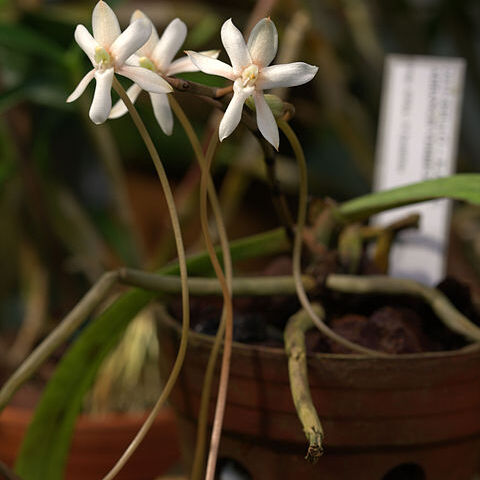Plants epiphytic or rarely epilithic; stems to 40 x 10 mm; leaves ligulate-oblong, thick-tissued, somewhat narrowed to the base, unequally bilobed, lobes rounded to acute, margins undulate, 50-200 x 20-50 mm. Inflorescences of several c. 200 mm long, 4-12-flowered racemes; peduncle with several tubular sheaths; bracts broadly ovate, apiculate, to 8 mm long. Flowers white, to 30 mm in diameter; pedicel plus ovary to 30 mm long. Sepals unequal; median erect, arching over the gynostemium, narrowly elliptic, apiculate, 11-20 x 4-8 mm; laterals deflexed, twisted to face backwards, linear-elliptic, acute, 16-21 x 3-5 mm. Petals reflexed, narrowly oblanceolate, acute, 14-20 x 6-8 mm. Lip deflexed, narrowly oblong, apically conduplicate, basally the margins decurved, 16-18 x 6-9 mm; spur pendent, thickened in the apical half, 120-160 mm long, entrance with 2-4 longitudinal ridges. Gynostemium erect, 6 mm tall.
Leaves 2–6, distichous, sometimes deciduous in the dry season, 5–20 × 2–5 cm, oblong-ligulate, undulate on the margins, subequally 2-lobed at the apex with acute or rounded lobes; lamina thick and fleshy, grey-green, often with a red-purple margin.
Lip 11–15(20) × 5–9(10) mm, oblong-obovate or pandurate, somewhat constricted in basal half, with 2 or more ridges at the base in the mouth of the spur; spur 12–20 cm long, flexuous, thickened in apical half.
Epiphyte. Stems up to 150 mm long. Leaves very thick, greyish green, sometimes with a reddish margin, but venation not distinct. Lip with 2 longitudinal ridges in mouth. Spur 120-160 mm long. Flowers white.
Dorsal sepal arching over the column, 11–19 × 4–8 mm, ovate, apiculate; lateral sepals spreading or deflexed, 14–18(22) × 3–8 mm, oblong-ligulate, often falcate, apiculate.
Epiphytic or lithophytic herb; stem woody, up to 5 cm long; roots numerous, 5–9 mm in diameter.
Flowers white, the spur tinged with green, rarely with pink, set 1.5–3.5 cm apart.
Inflorescences arising below the leaves, 20–60 cm long, 4–16-flowered.
Petals reflexed, 12–18(21) × 3.5–8 mm, obovate-oblong, apiculate.
Capsules c. 30 × 1.2 cm, ellipsoid.
Bracts up to 10 mm long, ovate.
Pedicel and ovary 2–4 cm long.
Column 3–5 mm long.

